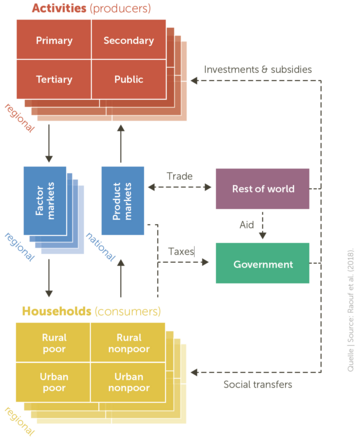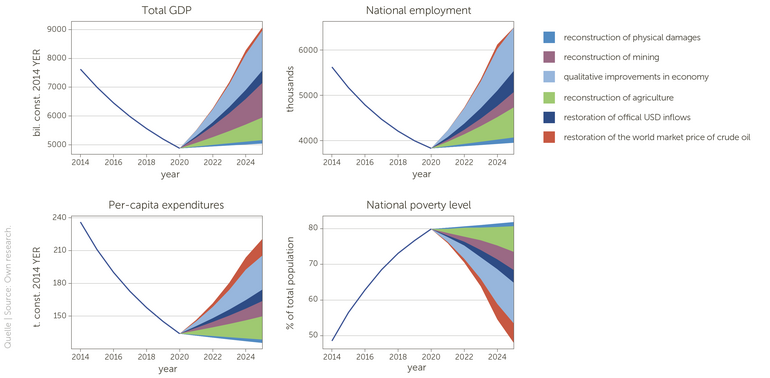Kiel Institute Highlights
Preparing for the end of the conflict - model simulations for the Yemeni economy
Economic data from countries in the midst of massive armed conflicts are generally only available in fragments or even missing entirely. This makes it all the more difficult to initiate the right measures to rebuild the country when the time comes. A model simulation can provide valuable information here, as we show with the example of Yemen, which according to our findings—should the country be given the chance to rebuild—would benefit most from targeted support for mining and agriculture.

Yemen, one of the poorest countries in the world, has been unstable since the Arab Spring in 2011. After several years of turbulence, the full-fledged armed conflict began in March 2015, when exiled interim president Abd-Rabbu Mansour Hadi sought the military intervention of the Arab Coalition to restore his government. The conflict had catastrophic consequences for the Yemeni people and caused an unprecedented humanitarian crisis.
The Yemeni economy is likewise suffering massively from the consequences of the armed conflict, which caused forced displacements, destroyed large parts of the country, severely restricted the mobility of goods and people, and made it virtually impossible for the country’s population to get ahead economically and socially. These multidimensional impacts and a lack of data make it very difficult to reliably assess the exact state of Yemen’s economy. Should an end to the conflict come into sight at some point, however, a realistic assessment would be very helpful as a basis for political decisions around reconstruction and reconciliation.
Data are scarce in troubled regions
Three issues make a realistic assessment of the situation in Yemen difficult. Firstly, official statistics in Yemen have not been updated since March 2015. Secondly, there is no perfect indicator that captures the full extent of the many possible impacts. As a result, when estimating the current state of the economy, various international organizations and policy makers have to rely on anecdotal evidence. Thirdly, and most importantly, the absence of reliable counterfactuals could hamper impact assessment.
Standard tools, such as macroeconometric models, are data-intensive and therefore cannot be used to decompose the impact of conflict shocks on the Yemeni economy or forecast its development. Given such a data scarcity environment, we had to draw on simulation modeling methods and estimate conflict impact and post-conflict reconstruction of the Yemeni economy.
Methodology: How fragmented evidence can be modeled systematically
The starting point of our analysis was the compilation of Yemen’s latest available macro- and micro-level data into a comprehensive economy-wide database that represents the pre-conflict economy. These include, for example, the national accounts (2014), household survey (2014), and industrial survey (2013). As the next step, we analyzed various fragmented reports on conflict damage in the country and compiled a set of quantifiable shocks known to have affected the country between 2015 and 2020. Then we integrated compiled information on the conflict shocks into Yemen’s Computable General Equilibrium (CGE) model andsimulated the degradation of economic activity and household income throughout the conflict phase from 2015 to 2020. The CGE model takes into account the linkages between producers and consumers, the government, and the rest of the world, both across markets for goods and production factors and via financial transactions, and therefore captures not only the direct but also the indirect effects of conflict shocks (figure 1).
Finally, we assumed the conflict would end in 2021 and analyzed the spectrum of the country’s possible post-conflict pathways by 2025 (ranging from complete stagnation at 2020 levels to complete recovery to the pre-conflict level of 2014).
Estimates of the main economic indicators over the conflict and post-conflict phases in Yemen

Results and recommendations for reconstruction
Even prior to the outbreak of conflict, Yemen was among the world’s least developed and poorest countries, with an annual GDP per capita of USD 1,351 and almost half of the population (48.6 percent) living below the national poverty line.
Conflict-related shocks have devastated the already impoverished country (figure 2, 2014–2020). According to our estimates, GDP contracted by 36 percent between 2014 and 2020, with the most severe economic losses associated with disruption of the mining and agriculture sectors. The poverty rate reached 79.9 percent of the population, with a particularly dire situation in rural areas, where nine out of ten residents now live below the poverty line.
Consequently, recovery of mining and agriculture should be given the highest priority as it is estimated to provide the fastest route to the country’s revival (figure 2, 2021–2025). In particular, the mining sector’s recovery is likely to be the most eff ective way of boosting the post-conflict economy, while a recovery in agriculture would have the greatest impact on poverty reduction and real per-capita consumption (see reconstruction scenarios for mining (purple) and agriculture (green)).
Pre-crisis structural weaknesses and as yet unquantified conflict legacy linger
At the same time, our estimates suggest that even if Yemen succeeds in off setting all conflict-related shocks, a return to the pre-conflict economic and poverty status quo is very unlikely without institutional reforms and overall qualitative improvements in the economy (light blue). However, as the country was unable to implement such policies for decades before the conflict, these scenarios seem overly optimistic. Furthermore, in the context of other as yet unquantified conflict legacy factors, such as malnutrition, disease, increased qat consumption, and other human capital depreciation factors, achieving pre-conflict income and poverty levels in Yemen seems very unlikely in the foreseeable future.
Given the established relationship between poverty and armed conflicts, our findings thus indicate that the country’s stabilization will require assistance beyond the currently estimated USD 32 billion 5-year plan to reconstruct damaged assets and sectors. As more detailed damage estimates and reconstruction plans are put in place for Yemen, our simulation-based findings can be used as a first step toward understanding a country’s status quo and reconstruction potential.
Related Publication
References:
Mukashov, A., C. Breisinger, W. Engelke und M. Wiebelt (2022). Modelling Conflict Impact and Post-Conflict Reconstruction: The Case of Yemen. Economic Systems 46 (1). https://doi.org/10.1016/j.ecosys.2022.100940
Raouf, M., et al. (2018). The (Arab) Agricultural Investment for Development Analyzer (AIDA): An Innovative Tool for Evidence-Based Planning. MENA RP Working Paper 06. International Food Policy Research Institute, Washington, DC.